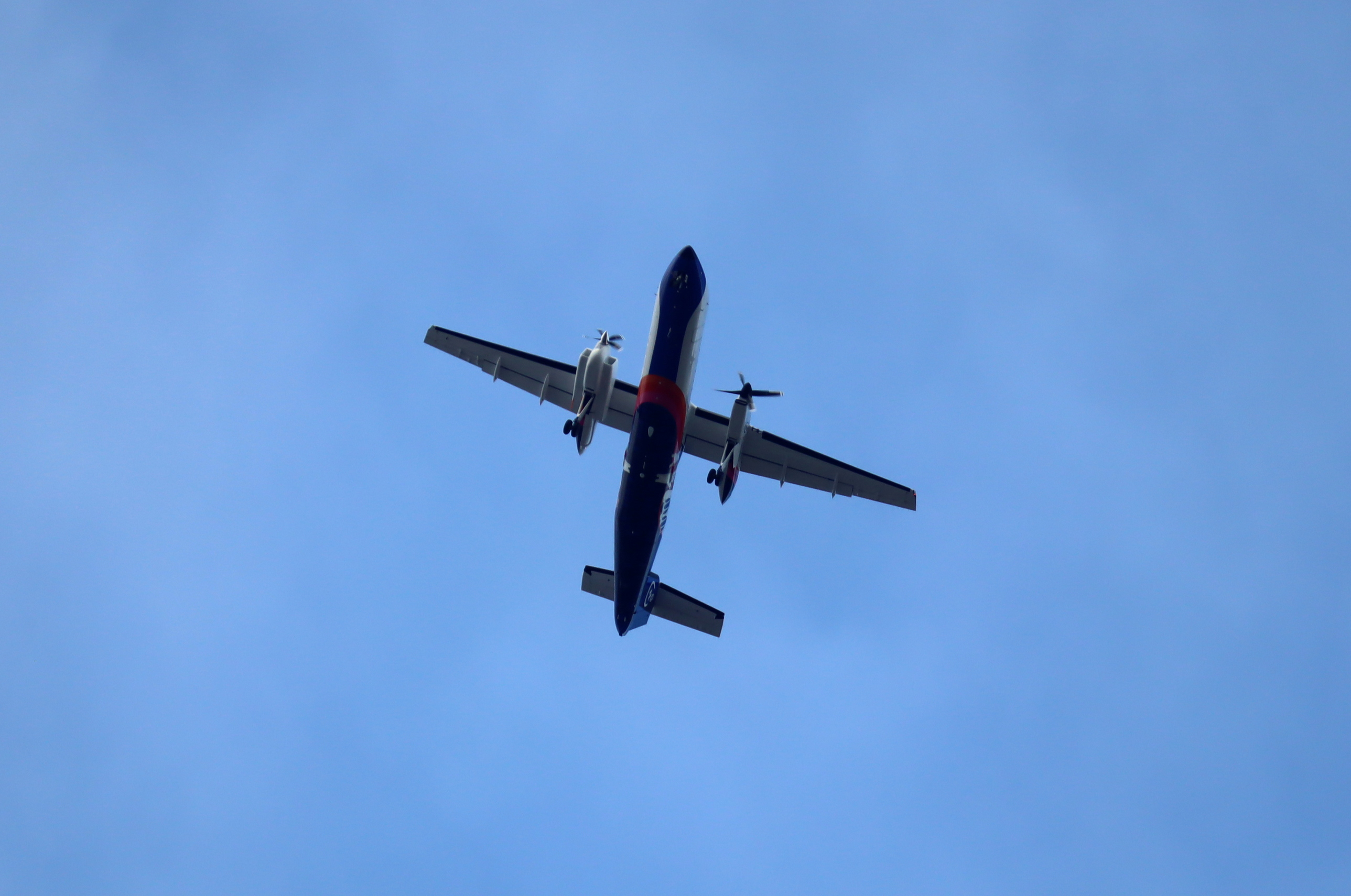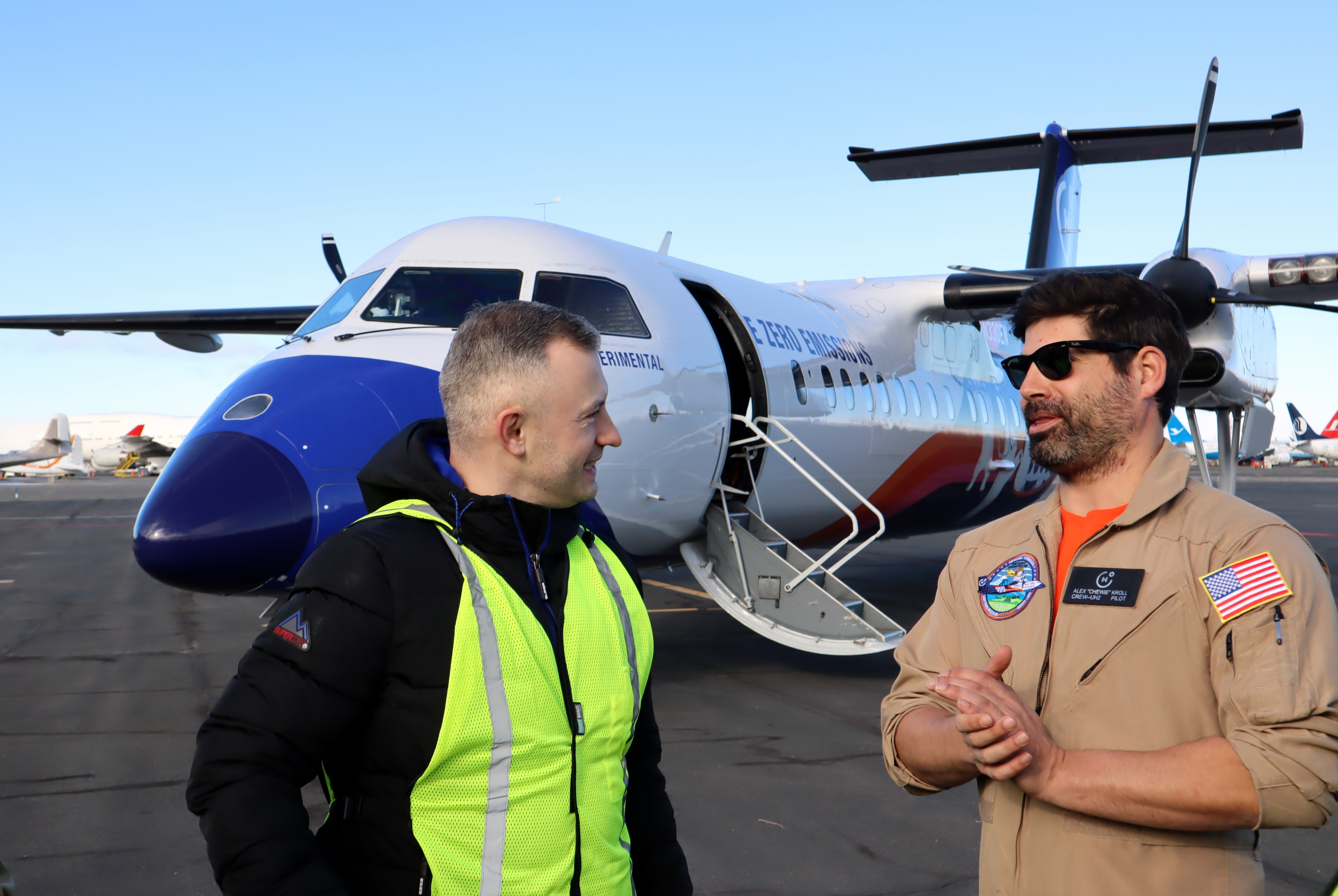Central Washington airport hosts first test flight of hydrogen-powered airliner
Tom Banse (Northwest News Network)
March 4, 2023
The largest aircraft yet to fly on hydrogen-electric power made a successful first flight in Moses Lake, Washington, on Thursday. The maiden flight of a converted turboprop airliner offered a preview of one possible pathway for how to make your future flights more eco-friendly. Hydrogen fuel is one of several options the aviation industry is testing to reduce its carbon footprint, but the technology still attracts notable skepticism.
Test pilot Alex Kroll was at the controls of the De Havilland Dash 8-300 with a retrofitted hydrogen fuel cell powertrain when it was cleared for takeoff on a partly cloudy morning. Was he nervous?
"It's healthy to be a little nervous going into anything,” the ex-Air Force pilot said afterwards. “But you've practiced and rehearsed well enough and frequently enough that you're confident the system will perform."

The Universal Hydrogen flight test crew posed for pictures after a successful first flight of the company's hydrogen-electric Dash 8 airliner on March 2, 2023.
Tom Banse / NW News Network
And perform it did. Kroll, a co-pilot and a flight engineer ascended to 3,500 feet in the brightly painted, twin engine commuter plane. They flew two wide figure eights around the airfield before coming in for a smooth touchdown about 15 minutes later.
A crowd of investors, ground crew and about a dozen airline VIPs gathered beside the runway to watch. The more than 60 onlookers appeared to forget for a moment how cold the morning was as they heartily cheered the liftoff and landing.
"It feels like a normal airplane,” Kroll said. “You hardly know the engine on the right has been modified."
For the first flight, one of the Dash 8's two motors was powered by the hydrogen fuel cells while the other ran on regular jet fuel just to be safe. A California-based startup named Universal Hydrogen directed the conversion. The company took out seats in the back to make room for a compressed liquid hydrogen tank. The fuel cells combine the hydrogen with air to produce electricity and water. The electricity powers the propeller. The only exhaust is water vapor.
At a post-flight reception, Universal Hydrogen CEO Paul Eremenko lifted a glass to toast what he called, “the beginning of a new golden age of aviation.”
And perform it did. Kroll, a co-pilot and a flight engineer ascended to 3,500 feet in the brightly painted, twin engine commuter plane. They flew two wide figure eights around the airfield before coming in for a smooth touchdown about 15 minutes later.
A crowd of investors, ground crew and about a dozen airline VIPs gathered beside the runway to watch. The more than 60 onlookers appeared to forget for a moment how cold the morning was as they heartily cheered the liftoff and landing.
"It feels like a normal airplane,” Kroll said. “You hardly know the engine on the right has been modified."
For the first flight, one of the Dash 8's two motors was powered by the hydrogen fuel cells while the other ran on regular jet fuel just to be safe. A California-based startup named Universal Hydrogen directed the conversion. The company took out seats in the back to make room for a compressed liquid hydrogen tank. The fuel cells combine the hydrogen with air to produce electricity and water. The electricity powers the propeller. The only exhaust is water vapor.
At a post-flight reception, Universal Hydrogen CEO Paul Eremenko lifted a glass to toast what he called, “the beginning of a new golden age of aviation.”

The hydrogen-electric motor and propeller under the wing at left differed from the conventional turboprop engine at right, requiring skilled piloting.
Tom Banse / NW News Network
“Yeah, pretty friggin' amazing,” he enthused to the attendees before they clinked their champagne flutes. “I think we really witnessed something historic here."
Eremenko said his company has an ambitious business plan to begin deliveries of converted twin engine turboprops to regional airlines beginning in late 2025. That assumes timely government certification of the new technology. A distinguishing feature of Universal Hydrogen’s offering is a modular fuel capsule that can be swapped in and out of an airliner fuselage to refuel without requiring new airport infrastructure.
"In general, I would say the industry is not yet on board with hydrogen. So that was one of the reasons today was such a historic day," Eremenko said in an interview Thursday. "I think the tide will turn. It will turn as we retire the risks, or the perceived risks, associated with hydrogen aviation — whether it is certification, or hydrogen supply, or hydrogen logistics, passenger acceptance."
Retired Boeing CEO Phil Condit is one of the skeptics. He cast doubt on hydrogen during a recent guest lecture at the University of Washington. He cited inefficiencies in its production and distribution. Condit said he is most keen on biofuels for zero emissions flight because they are essentially a drop in replacement for kerosene jet fuel.
"I can put it in an airplane that exists today and run that airplane," Condit said. "Can you get the costs down, that is the question."
What the industry calls sustainable aviation fuel is quite expensive and in limited supply currently. Condit and most other aerospace engineers say batteries are too heavy to power large commercial airplanes. Eremenko for his part scoffs at the touted benefits of synthetic fuels and biofuels, calling them a stopgap, “band aid” solution that fails to drive down emissions enough.

Universal Hydrogen CEO Paul Eremenko congratulated test pilot Alex Kroll after the landing.
Tom Banse / NW News Network
Major airlines are hedging their bets by investing in startups with different technologies. For example, Alaska Airlines has run periodic flight tests with a biofuel blend while also partnering with ZeroAvia, a competitor of Universal Hydrogen in the zero emission airplane conversion business. United Airlines has placed orders for large quantities of biofuel while also committing to buy several models of in-development battery-electric commuter aircraft.
Moses Lake airport director Rich Mueller said Central Washington has now hosted demonstrations of all of the leading options to power guilt-free air travel; namely, electric batteries, biofuels and hydrogen.
"I know that a lot of people think of Moses Lake as the stop on I-90 on their way to Spokane or vice versa," Mueller said. "But for what is going on in the future of aviation, we're finding ourselves right in the middle of it.”
Moses Lake has long attracted test flight campaigns because of its good flying weather, fairly uncrowded skies and the extra-long runways at the airfield, the latter a legacy from Grant County International Airport's former life as a Cold War-era Air Force base. Around the time the hydrogen-electric aircraft finishes testing there later this year, NASA contractors are expected to set up shop with a four-engine hybrid electric aircraft demonstrator. Everett, Washington-based electric motor maker MagniX is leading that contact in partnership with aircraft modification and flight testing specialist AeroTEC. The airframe they have chosen for the NASA-funded project is a retired De Havilland Dash 7.
The previous largest plane to fly on hydrogen-electric power was a 19-seat Dornier 228 regional airliner. ZeroAvia converted that plane in England and it completed its first flight in January. The Dash 8-300 that Universal Hydrogen is using as its testbed carried 50+ passengers in commercial service before its insides were gutted for the powertrain retrofit.
Universal Hydrogen is also working on a conversion kit for a larger model of regional airliner, the 72-seat ATR 72-600. This is the model expected to enter revenue service with the two airlines that are first in line to take delivery, Massachusetts-based Connect Airlines and French carrier Amelia Airlines.
“It’s great to see the progress of the technology, great to see the first flight,” said Scott Brownrigg, director of public affairs for Connect Airlines. “We’re really excited to be the first U.S. airline to offer zero emission flying through these zero emission aircraft.”
Brownrigg traveled to Moses Lake to witness the first flight of the hydrogen-powered airplane. The startup regional airline placed a firm order last year for 75 ATRs with the hydrogen conversion and has an option to take an additional 25 hydrogen-electric planes.
No comments:
Post a Comment